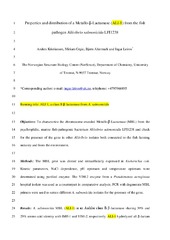Properties and distribution of a metallo-β-lactamase (ALI-1) from the fish pathogen Aliivibrio salmonicida LFI1238
Permanent link
https://hdl.handle.net/10037/9090Date
2015Type
Journal articleTidsskriftartikkel
Peer reviewed
Abstract
Objectives. To characterize the chromosome-encoded metallo-β-lactamase (MBL) from the psychrophilic, marine fish-pathogenic bacterium Aliivibrio salmonicida LFI1238 and check for the presence of the gene in other Aliivibrio isolates both connected to the fish-farming industry and from the environment.
Methods. The MBL gene was cloned and intracellularly expressed in Escherichia coli. Kinetic parameters, NaCl dependence, pH optimum and temperature optimum were determined using purified enzyme. The VIM-2 enzyme from a Pseudomonas aeruginosa hospital isolate was used as a counterpart in comparative analysis. PCRs with degenerate MBL primers were used to screen different A. salmonicida isolates for the presence of the gene.
Results. A. salmonicida MBL (ALI-1) is an Ambler class B β-lactamase sharing 39% and 29% amino acid identity with IMP-1 and VIM-2, respectively. ALI-1 hydrolysed all β-lactam antibiotics tested, except for the monobactam aztreonam and the penicillin piperacillin. A profound increase in activity was observed when adding NaCl to the assay mixture (60% active without addition of NaCl, increasing to 100% at 0.5 M NaCl). The increase was less noticeable for VIM-2 (100% active at 0.2 M NaCl). ALI-1 appears to be ubiquitous in nature as it is found in Aliivibrio isolates not affected by human activity.
Conclusions. This work provides more data for the ever-expanding MBL group of enzymes. These periplasmic enzymes are activated by addition of NaCl, and the marine enzyme is highly salt tolerant and cold active. The observed enzyme properties very likely reflect the conditions that the enzymes face in situ.
Description
Accepted manuscript version. Published version at http://doi.org/10.1093/jac/dku433.


 English
English norsk
norsk